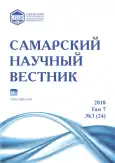Stone implement from the early Neolithic layers in Rakushechny Yar (on the example of the researches of 2016-2017)
- Authors: Gorodetskaya S.P.1
-
Affiliations:
- State Hermitage Museum
- Issue: Vol 7, No 3 (2018)
- Pages: 153-159
- Section: 07.00.00 – Historical Sciences and Archaeology
- URL: https://journals.rcsi.science/2309-4370/article/view/21707
- DOI: https://doi.org/10.17816/snv201873204
- ID: 21707
Cite item
Full Text
Abstract
The article shows the analysis of the collection of the stone artifacts obtained as a result of excavations of the early Neolithic layers of the site Rakushechny Yar. The collection of the stone tools makes it possible to get an idea about the flaking technology, oriented to obtaining blades. However, the absence of the products of debitage on the site indicates that flaking and tool production were realized outside the site. For secondary modification inhabitants of the site used such techniques as retouching and polishing. The tools assemblage was represented mainly by points that were used as drills, end-scrapers and polished axes, which indicates the specific economic activities of the inhabitants of the site, associated with the woodworking. The stone implement of the site has analogies not only in the Neolithic sites of the region, but also in the Neolithic stone implements of the sites of the Lower Volga and Northern Caspian Regions. Taking into account that the investigated part of the site was a coastal zone at one time, as well as the presence of a large number of fish bones in the lower layers, it can be assumed that the use of the above categories of tools was somehow connected with fishing. This assumption can be confirmed by microwear analysis of the stone tools.
Full Text
##article.viewOnOriginalSite##About the authors
Susanna Pavlovna Gorodetskaya
State Hermitage Museum
Author for correspondence.
Email: yaguanarex@rambler.ru
specialist of Exhibition Activities Department
Russian Federation, St. PetersburgReferences
- Белановская Т.Д. Из древнейшего прошлого Нижнего Подонья: Поселение времени неолита и энеолита Ракушечный Яр. СПб.: Издательство С.-Петербургского университета, 1995. 198 с.
- Tsybrij Andrey, Tsybrij Viktor, Dolbunova Ekaterina, Mazurkevich Andrey, Kulkova Marianna and Zaitseva Ganna. Radiocarbon chronology of Neolithic in the Lower Don and North-eastern Azov Sea // Documenta Praehistorica XLIV. Ljubljana, 2017. С. 204-222.
- Гиря Е.Ю., Лозовский В.М. Сравнительный морфологический анализ полноты технологических контекстов каменных индустрий // Каменный век: от Атлантики до Пацифики. СПб.: МАЭ РАН; ИИМК РАН, 2014. С. 52-84.
- Гиря Е.Ю. Технологический анализ каменных индустрий. Методика микро-макроанализа древних орудий труда. СПб.: ИИМК РАН, 1997. 198 с.
- Мазуркевич А.Н., Долбунова Е.В., Мэгро Й. Памятник Ракушечный Яр и проблемы неолитизации Восточной Европы // Пiвнiчне Приазов’я кам’яного вiку-енеолiту: матерiали мiжнародноi науковоi конференцii. Мелитополь, 2013. С. 106-114.
- Цыбрий В.В. Неолит Нижнего Дона и Северо-Восточного Приазовья. Ростов-на-Дону: Изд-во АПСН СКНЦ ВШ ЮФУ, 2008. 205 с.
- Юдин А.И. Варфоломеевская стоянка и неолит степного Поволжья. Саратов: Изд-во Саратовского ун-та, 200 с.
- Кольцов П.М. Неолитическое поселение Джангар // Археологические культуры Северного Прикаспия. Куйбышев: КГПИ, 1988. С. 52-92.
Supplementary files









